Sustainability of Greater Sydney Region: Criteria, Evaluation, Future
VerifiedAdded on 2022/12/23
|10
|2563
|72
Essay
AI Summary
This essay provides a detailed analysis of the sustainability of the Greater Sydney Region. It begins by defining sustainability and outlining the key criteria for measuring it in cities, including employment, technological advancement, crime rates, and biodiversity. The essay then evaluates the current sus...
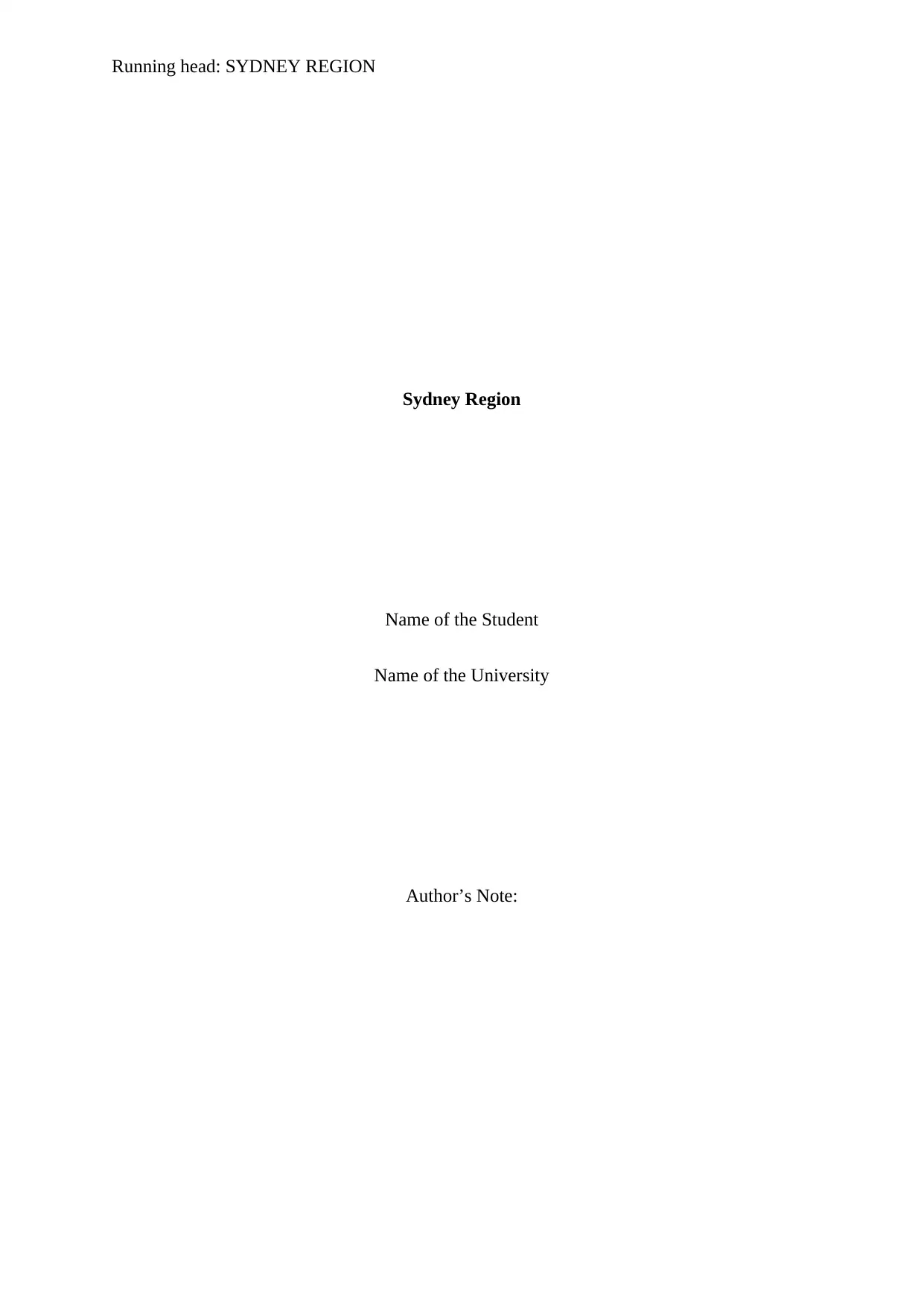
Running head: SYDNEY REGION
Sydney Region
Name of the Student
Name of the University
Author’s Note:
Sydney Region
Name of the Student
Name of the University
Author’s Note:
Paraphrase This Document
Need a fresh take? Get an instant paraphrase of this document with our AI Paraphraser
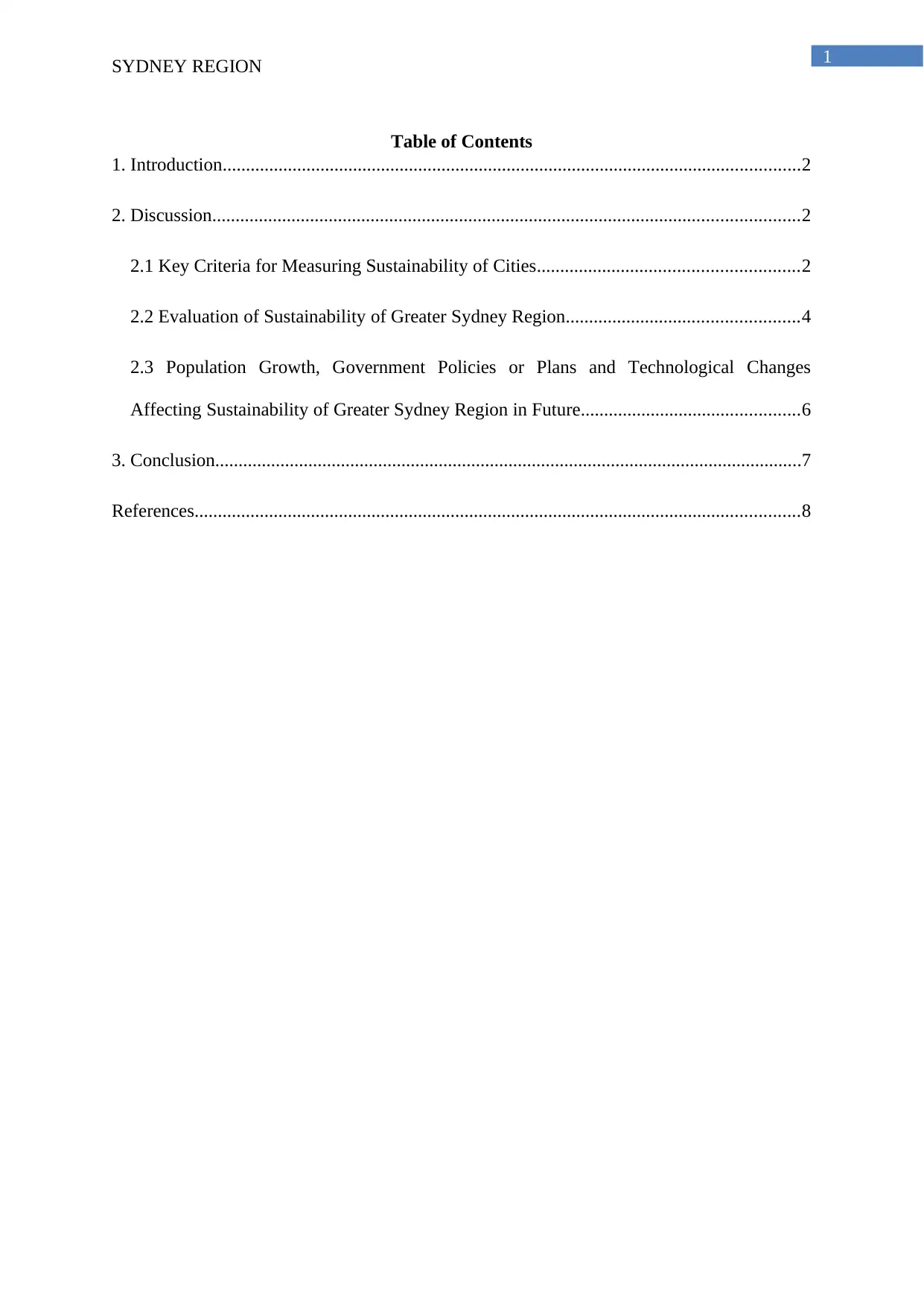
1
SYDNEY REGION
Table of Contents
1. Introduction............................................................................................................................2
2. Discussion..............................................................................................................................2
2.1 Key Criteria for Measuring Sustainability of Cities........................................................2
2.2 Evaluation of Sustainability of Greater Sydney Region..................................................4
2.3 Population Growth, Government Policies or Plans and Technological Changes
Affecting Sustainability of Greater Sydney Region in Future...............................................6
3. Conclusion..............................................................................................................................7
References..................................................................................................................................8
SYDNEY REGION
Table of Contents
1. Introduction............................................................................................................................2
2. Discussion..............................................................................................................................2
2.1 Key Criteria for Measuring Sustainability of Cities........................................................2
2.2 Evaluation of Sustainability of Greater Sydney Region..................................................4
2.3 Population Growth, Government Policies or Plans and Technological Changes
Affecting Sustainability of Greater Sydney Region in Future...............................................6
3. Conclusion..............................................................................................................................7
References..................................................................................................................................8
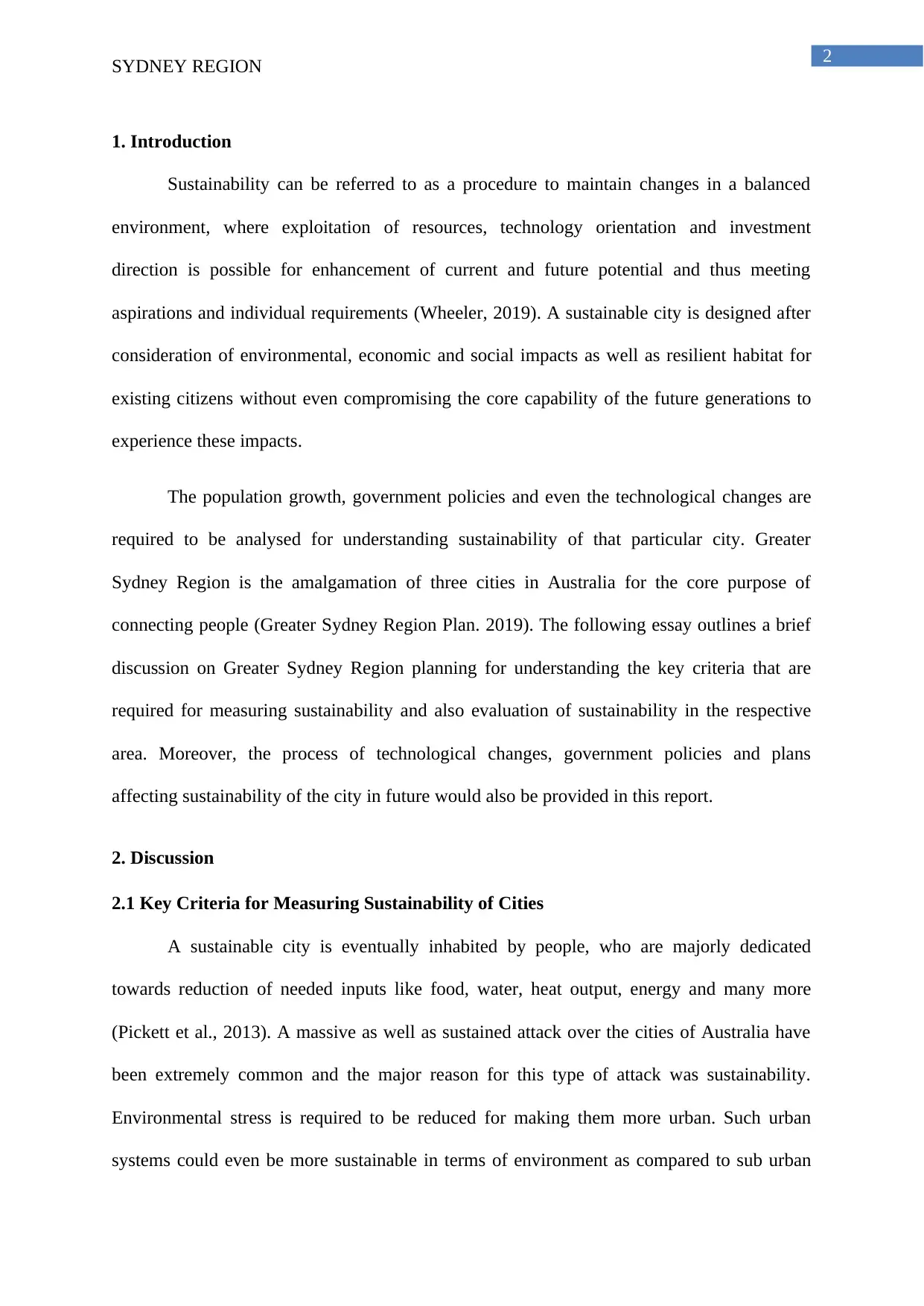
2
SYDNEY REGION
1. Introduction
Sustainability can be referred to as a procedure to maintain changes in a balanced
environment, where exploitation of resources, technology orientation and investment
direction is possible for enhancement of current and future potential and thus meeting
aspirations and individual requirements (Wheeler, 2019). A sustainable city is designed after
consideration of environmental, economic and social impacts as well as resilient habitat for
existing citizens without even compromising the core capability of the future generations to
experience these impacts.
The population growth, government policies and even the technological changes are
required to be analysed for understanding sustainability of that particular city. Greater
Sydney Region is the amalgamation of three cities in Australia for the core purpose of
connecting people (Greater Sydney Region Plan. 2019). The following essay outlines a brief
discussion on Greater Sydney Region planning for understanding the key criteria that are
required for measuring sustainability and also evaluation of sustainability in the respective
area. Moreover, the process of technological changes, government policies and plans
affecting sustainability of the city in future would also be provided in this report.
2. Discussion
2.1 Key Criteria for Measuring Sustainability of Cities
A sustainable city is eventually inhabited by people, who are majorly dedicated
towards reduction of needed inputs like food, water, heat output, energy and many more
(Pickett et al., 2013). A massive as well as sustained attack over the cities of Australia have
been extremely common and the major reason for this type of attack was sustainability.
Environmental stress is required to be reduced for making them more urban. Such urban
systems could even be more sustainable in terms of environment as compared to sub urban
SYDNEY REGION
1. Introduction
Sustainability can be referred to as a procedure to maintain changes in a balanced
environment, where exploitation of resources, technology orientation and investment
direction is possible for enhancement of current and future potential and thus meeting
aspirations and individual requirements (Wheeler, 2019). A sustainable city is designed after
consideration of environmental, economic and social impacts as well as resilient habitat for
existing citizens without even compromising the core capability of the future generations to
experience these impacts.
The population growth, government policies and even the technological changes are
required to be analysed for understanding sustainability of that particular city. Greater
Sydney Region is the amalgamation of three cities in Australia for the core purpose of
connecting people (Greater Sydney Region Plan. 2019). The following essay outlines a brief
discussion on Greater Sydney Region planning for understanding the key criteria that are
required for measuring sustainability and also evaluation of sustainability in the respective
area. Moreover, the process of technological changes, government policies and plans
affecting sustainability of the city in future would also be provided in this report.
2. Discussion
2.1 Key Criteria for Measuring Sustainability of Cities
A sustainable city is eventually inhabited by people, who are majorly dedicated
towards reduction of needed inputs like food, water, heat output, energy and many more
(Pickett et al., 2013). A massive as well as sustained attack over the cities of Australia have
been extremely common and the major reason for this type of attack was sustainability.
Environmental stress is required to be reduced for making them more urban. Such urban
systems could even be more sustainable in terms of environment as compared to sub urban
⊘ This is a preview!⊘
Do you want full access?
Subscribe today to unlock all pages.

Trusted by 1+ million students worldwide
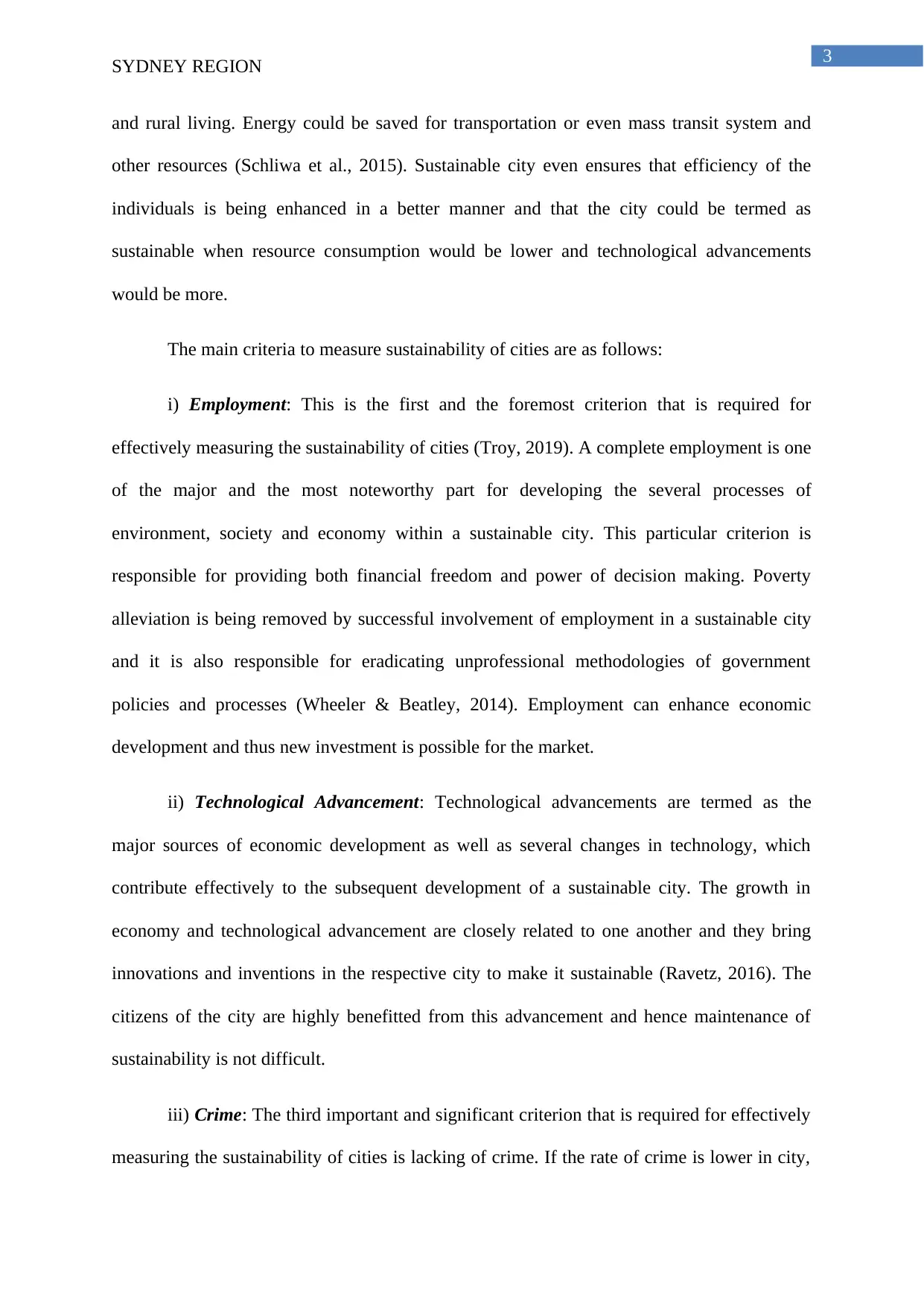
3
SYDNEY REGION
and rural living. Energy could be saved for transportation or even mass transit system and
other resources (Schliwa et al., 2015). Sustainable city even ensures that efficiency of the
individuals is being enhanced in a better manner and that the city could be termed as
sustainable when resource consumption would be lower and technological advancements
would be more.
The main criteria to measure sustainability of cities are as follows:
i) Employment: This is the first and the foremost criterion that is required for
effectively measuring the sustainability of cities (Troy, 2019). A complete employment is one
of the major and the most noteworthy part for developing the several processes of
environment, society and economy within a sustainable city. This particular criterion is
responsible for providing both financial freedom and power of decision making. Poverty
alleviation is being removed by successful involvement of employment in a sustainable city
and it is also responsible for eradicating unprofessional methodologies of government
policies and processes (Wheeler & Beatley, 2014). Employment can enhance economic
development and thus new investment is possible for the market.
ii) Technological Advancement: Technological advancements are termed as the
major sources of economic development as well as several changes in technology, which
contribute effectively to the subsequent development of a sustainable city. The growth in
economy and technological advancement are closely related to one another and they bring
innovations and inventions in the respective city to make it sustainable (Ravetz, 2016). The
citizens of the city are highly benefitted from this advancement and hence maintenance of
sustainability is not difficult.
iii) Crime: The third important and significant criterion that is required for effectively
measuring the sustainability of cities is lacking of crime. If the rate of crime is lower in city,
SYDNEY REGION
and rural living. Energy could be saved for transportation or even mass transit system and
other resources (Schliwa et al., 2015). Sustainable city even ensures that efficiency of the
individuals is being enhanced in a better manner and that the city could be termed as
sustainable when resource consumption would be lower and technological advancements
would be more.
The main criteria to measure sustainability of cities are as follows:
i) Employment: This is the first and the foremost criterion that is required for
effectively measuring the sustainability of cities (Troy, 2019). A complete employment is one
of the major and the most noteworthy part for developing the several processes of
environment, society and economy within a sustainable city. This particular criterion is
responsible for providing both financial freedom and power of decision making. Poverty
alleviation is being removed by successful involvement of employment in a sustainable city
and it is also responsible for eradicating unprofessional methodologies of government
policies and processes (Wheeler & Beatley, 2014). Employment can enhance economic
development and thus new investment is possible for the market.
ii) Technological Advancement: Technological advancements are termed as the
major sources of economic development as well as several changes in technology, which
contribute effectively to the subsequent development of a sustainable city. The growth in
economy and technological advancement are closely related to one another and they bring
innovations and inventions in the respective city to make it sustainable (Ravetz, 2016). The
citizens of the city are highly benefitted from this advancement and hence maintenance of
sustainability is not difficult.
iii) Crime: The third important and significant criterion that is required for effectively
measuring the sustainability of cities is lacking of crime. If the rate of crime is lower in city,
Paraphrase This Document
Need a fresh take? Get an instant paraphrase of this document with our AI Paraphraser
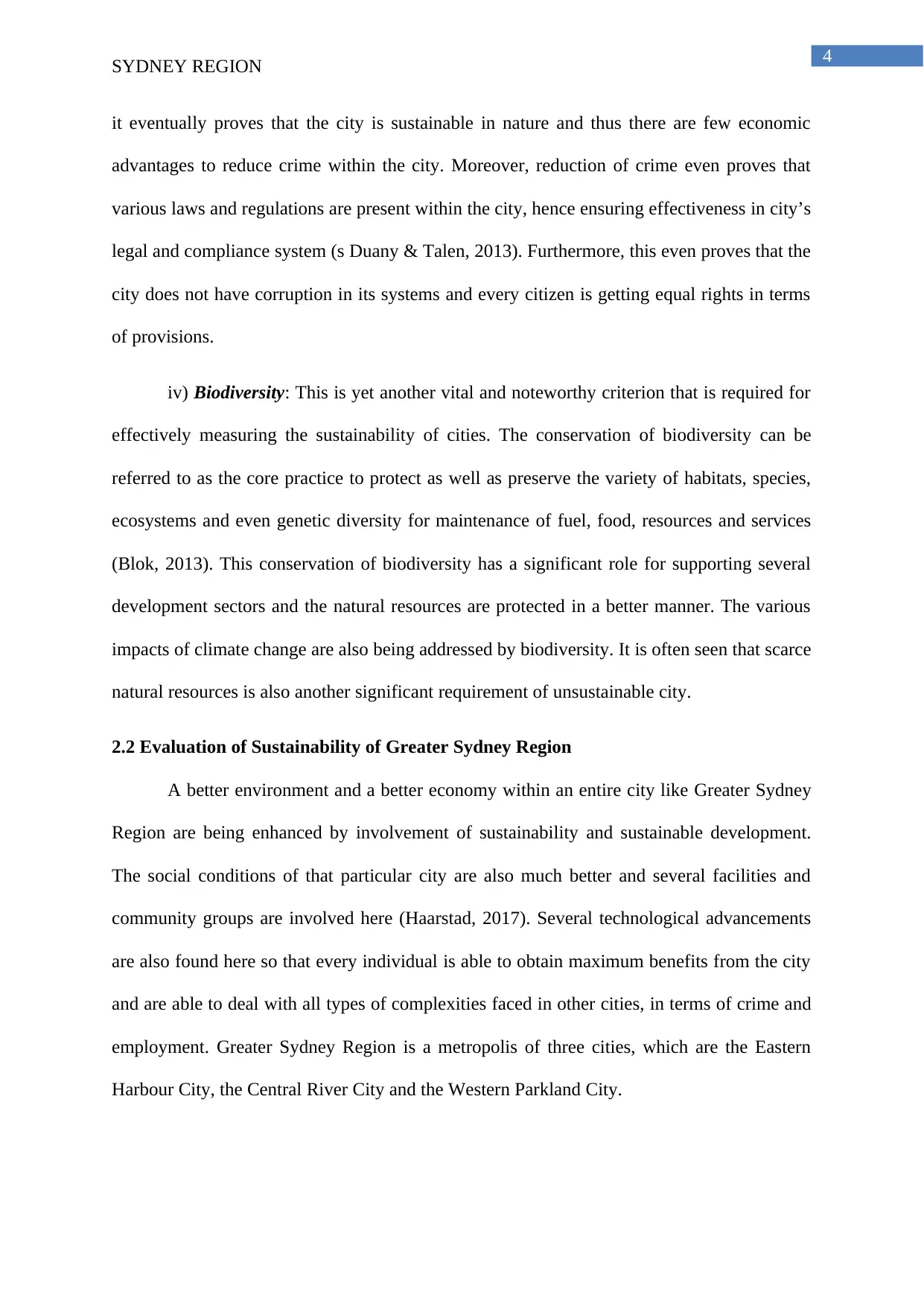
4
SYDNEY REGION
it eventually proves that the city is sustainable in nature and thus there are few economic
advantages to reduce crime within the city. Moreover, reduction of crime even proves that
various laws and regulations are present within the city, hence ensuring effectiveness in city’s
legal and compliance system (s Duany & Talen, 2013). Furthermore, this even proves that the
city does not have corruption in its systems and every citizen is getting equal rights in terms
of provisions.
iv) Biodiversity: This is yet another vital and noteworthy criterion that is required for
effectively measuring the sustainability of cities. The conservation of biodiversity can be
referred to as the core practice to protect as well as preserve the variety of habitats, species,
ecosystems and even genetic diversity for maintenance of fuel, food, resources and services
(Blok, 2013). This conservation of biodiversity has a significant role for supporting several
development sectors and the natural resources are protected in a better manner. The various
impacts of climate change are also being addressed by biodiversity. It is often seen that scarce
natural resources is also another significant requirement of unsustainable city.
2.2 Evaluation of Sustainability of Greater Sydney Region
A better environment and a better economy within an entire city like Greater Sydney
Region are being enhanced by involvement of sustainability and sustainable development.
The social conditions of that particular city are also much better and several facilities and
community groups are involved here (Haarstad, 2017). Several technological advancements
are also found here so that every individual is able to obtain maximum benefits from the city
and are able to deal with all types of complexities faced in other cities, in terms of crime and
employment. Greater Sydney Region is a metropolis of three cities, which are the Eastern
Harbour City, the Central River City and the Western Parkland City.
SYDNEY REGION
it eventually proves that the city is sustainable in nature and thus there are few economic
advantages to reduce crime within the city. Moreover, reduction of crime even proves that
various laws and regulations are present within the city, hence ensuring effectiveness in city’s
legal and compliance system (s Duany & Talen, 2013). Furthermore, this even proves that the
city does not have corruption in its systems and every citizen is getting equal rights in terms
of provisions.
iv) Biodiversity: This is yet another vital and noteworthy criterion that is required for
effectively measuring the sustainability of cities. The conservation of biodiversity can be
referred to as the core practice to protect as well as preserve the variety of habitats, species,
ecosystems and even genetic diversity for maintenance of fuel, food, resources and services
(Blok, 2013). This conservation of biodiversity has a significant role for supporting several
development sectors and the natural resources are protected in a better manner. The various
impacts of climate change are also being addressed by biodiversity. It is often seen that scarce
natural resources is also another significant requirement of unsustainable city.
2.2 Evaluation of Sustainability of Greater Sydney Region
A better environment and a better economy within an entire city like Greater Sydney
Region are being enhanced by involvement of sustainability and sustainable development.
The social conditions of that particular city are also much better and several facilities and
community groups are involved here (Haarstad, 2017). Several technological advancements
are also found here so that every individual is able to obtain maximum benefits from the city
and are able to deal with all types of complexities faced in other cities, in terms of crime and
employment. Greater Sydney Region is a metropolis of three cities, which are the Eastern
Harbour City, the Central River City and the Western Parkland City.
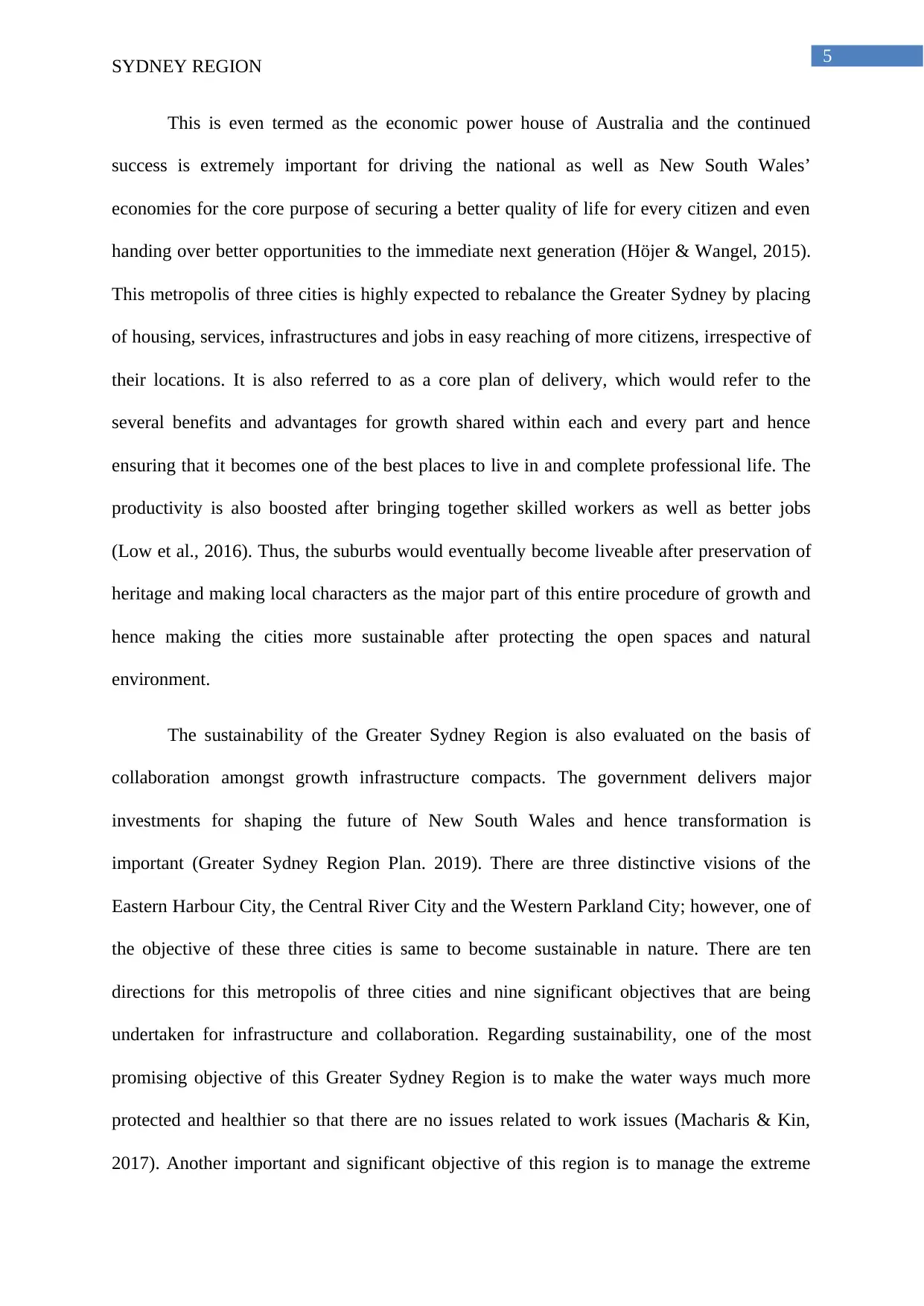
5
SYDNEY REGION
This is even termed as the economic power house of Australia and the continued
success is extremely important for driving the national as well as New South Wales’
economies for the core purpose of securing a better quality of life for every citizen and even
handing over better opportunities to the immediate next generation (Höjer & Wangel, 2015).
This metropolis of three cities is highly expected to rebalance the Greater Sydney by placing
of housing, services, infrastructures and jobs in easy reaching of more citizens, irrespective of
their locations. It is also referred to as a core plan of delivery, which would refer to the
several benefits and advantages for growth shared within each and every part and hence
ensuring that it becomes one of the best places to live in and complete professional life. The
productivity is also boosted after bringing together skilled workers as well as better jobs
(Low et al., 2016). Thus, the suburbs would eventually become liveable after preservation of
heritage and making local characters as the major part of this entire procedure of growth and
hence making the cities more sustainable after protecting the open spaces and natural
environment.
The sustainability of the Greater Sydney Region is also evaluated on the basis of
collaboration amongst growth infrastructure compacts. The government delivers major
investments for shaping the future of New South Wales and hence transformation is
important (Greater Sydney Region Plan. 2019). There are three distinctive visions of the
Eastern Harbour City, the Central River City and the Western Parkland City; however, one of
the objective of these three cities is same to become sustainable in nature. There are ten
directions for this metropolis of three cities and nine significant objectives that are being
undertaken for infrastructure and collaboration. Regarding sustainability, one of the most
promising objective of this Greater Sydney Region is to make the water ways much more
protected and healthier so that there are no issues related to work issues (Macharis & Kin,
2017). Another important and significant objective of this region is to manage the extreme
SYDNEY REGION
This is even termed as the economic power house of Australia and the continued
success is extremely important for driving the national as well as New South Wales’
economies for the core purpose of securing a better quality of life for every citizen and even
handing over better opportunities to the immediate next generation (Höjer & Wangel, 2015).
This metropolis of three cities is highly expected to rebalance the Greater Sydney by placing
of housing, services, infrastructures and jobs in easy reaching of more citizens, irrespective of
their locations. It is also referred to as a core plan of delivery, which would refer to the
several benefits and advantages for growth shared within each and every part and hence
ensuring that it becomes one of the best places to live in and complete professional life. The
productivity is also boosted after bringing together skilled workers as well as better jobs
(Low et al., 2016). Thus, the suburbs would eventually become liveable after preservation of
heritage and making local characters as the major part of this entire procedure of growth and
hence making the cities more sustainable after protecting the open spaces and natural
environment.
The sustainability of the Greater Sydney Region is also evaluated on the basis of
collaboration amongst growth infrastructure compacts. The government delivers major
investments for shaping the future of New South Wales and hence transformation is
important (Greater Sydney Region Plan. 2019). There are three distinctive visions of the
Eastern Harbour City, the Central River City and the Western Parkland City; however, one of
the objective of these three cities is same to become sustainable in nature. There are ten
directions for this metropolis of three cities and nine significant objectives that are being
undertaken for infrastructure and collaboration. Regarding sustainability, one of the most
promising objective of this Greater Sydney Region is to make the water ways much more
protected and healthier so that there are no issues related to work issues (Macharis & Kin,
2017). Another important and significant objective of this region is to manage the extreme
⊘ This is a preview!⊘
Do you want full access?
Subscribe today to unlock all pages.

Trusted by 1+ million students worldwide
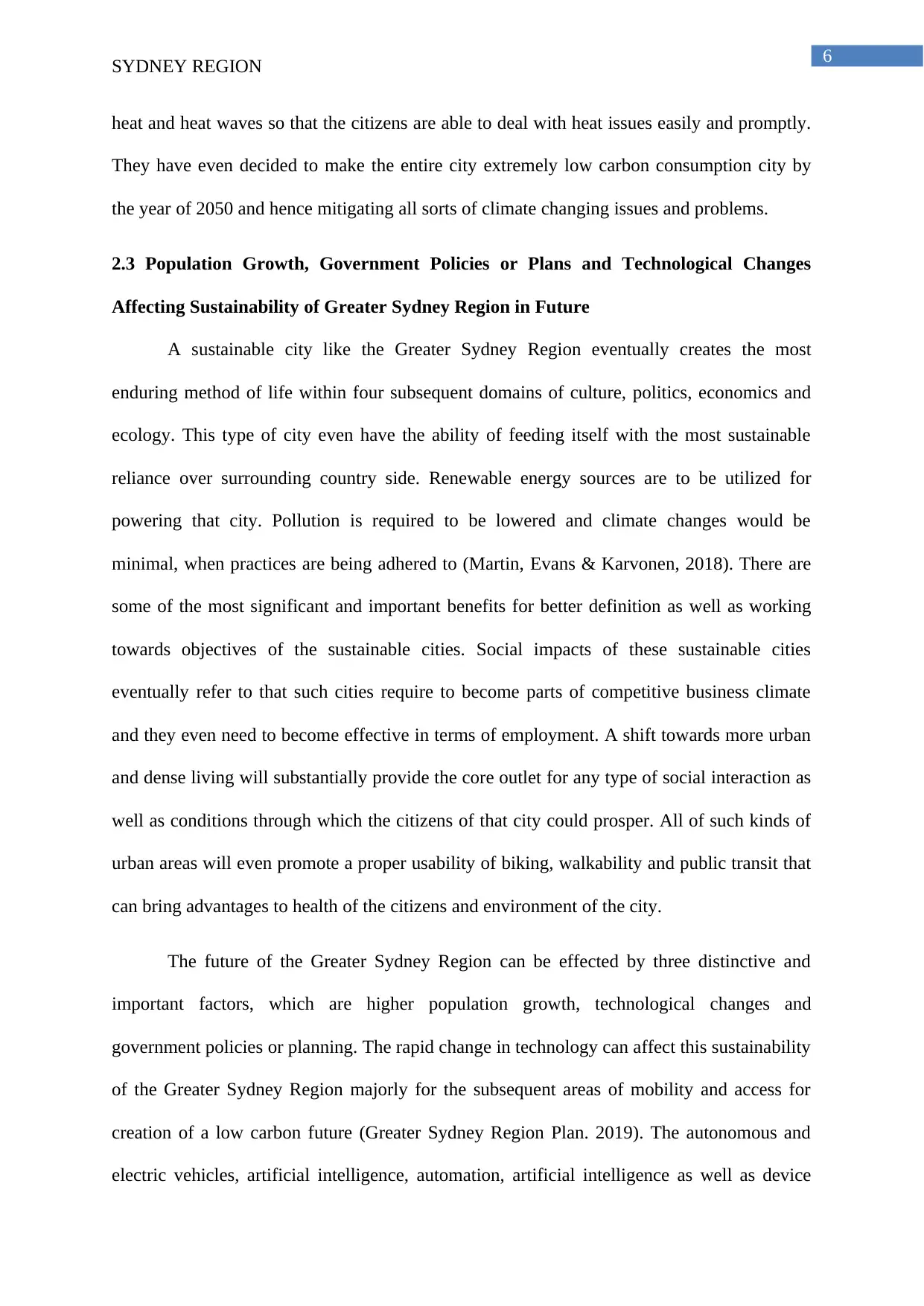
6
SYDNEY REGION
heat and heat waves so that the citizens are able to deal with heat issues easily and promptly.
They have even decided to make the entire city extremely low carbon consumption city by
the year of 2050 and hence mitigating all sorts of climate changing issues and problems.
2.3 Population Growth, Government Policies or Plans and Technological Changes
Affecting Sustainability of Greater Sydney Region in Future
A sustainable city like the Greater Sydney Region eventually creates the most
enduring method of life within four subsequent domains of culture, politics, economics and
ecology. This type of city even have the ability of feeding itself with the most sustainable
reliance over surrounding country side. Renewable energy sources are to be utilized for
powering that city. Pollution is required to be lowered and climate changes would be
minimal, when practices are being adhered to (Martin, Evans & Karvonen, 2018). There are
some of the most significant and important benefits for better definition as well as working
towards objectives of the sustainable cities. Social impacts of these sustainable cities
eventually refer to that such cities require to become parts of competitive business climate
and they even need to become effective in terms of employment. A shift towards more urban
and dense living will substantially provide the core outlet for any type of social interaction as
well as conditions through which the citizens of that city could prosper. All of such kinds of
urban areas will even promote a proper usability of biking, walkability and public transit that
can bring advantages to health of the citizens and environment of the city.
The future of the Greater Sydney Region can be effected by three distinctive and
important factors, which are higher population growth, technological changes and
government policies or planning. The rapid change in technology can affect this sustainability
of the Greater Sydney Region majorly for the subsequent areas of mobility and access for
creation of a low carbon future (Greater Sydney Region Plan. 2019). The autonomous and
electric vehicles, artificial intelligence, automation, artificial intelligence as well as device
SYDNEY REGION
heat and heat waves so that the citizens are able to deal with heat issues easily and promptly.
They have even decided to make the entire city extremely low carbon consumption city by
the year of 2050 and hence mitigating all sorts of climate changing issues and problems.
2.3 Population Growth, Government Policies or Plans and Technological Changes
Affecting Sustainability of Greater Sydney Region in Future
A sustainable city like the Greater Sydney Region eventually creates the most
enduring method of life within four subsequent domains of culture, politics, economics and
ecology. This type of city even have the ability of feeding itself with the most sustainable
reliance over surrounding country side. Renewable energy sources are to be utilized for
powering that city. Pollution is required to be lowered and climate changes would be
minimal, when practices are being adhered to (Martin, Evans & Karvonen, 2018). There are
some of the most significant and important benefits for better definition as well as working
towards objectives of the sustainable cities. Social impacts of these sustainable cities
eventually refer to that such cities require to become parts of competitive business climate
and they even need to become effective in terms of employment. A shift towards more urban
and dense living will substantially provide the core outlet for any type of social interaction as
well as conditions through which the citizens of that city could prosper. All of such kinds of
urban areas will even promote a proper usability of biking, walkability and public transit that
can bring advantages to health of the citizens and environment of the city.
The future of the Greater Sydney Region can be effected by three distinctive and
important factors, which are higher population growth, technological changes and
government policies or planning. The rapid change in technology can affect this sustainability
of the Greater Sydney Region majorly for the subsequent areas of mobility and access for
creation of a low carbon future (Greater Sydney Region Plan. 2019). The autonomous and
electric vehicles, artificial intelligence, automation, artificial intelligence as well as device
Paraphrase This Document
Need a fresh take? Get an instant paraphrase of this document with our AI Paraphraser
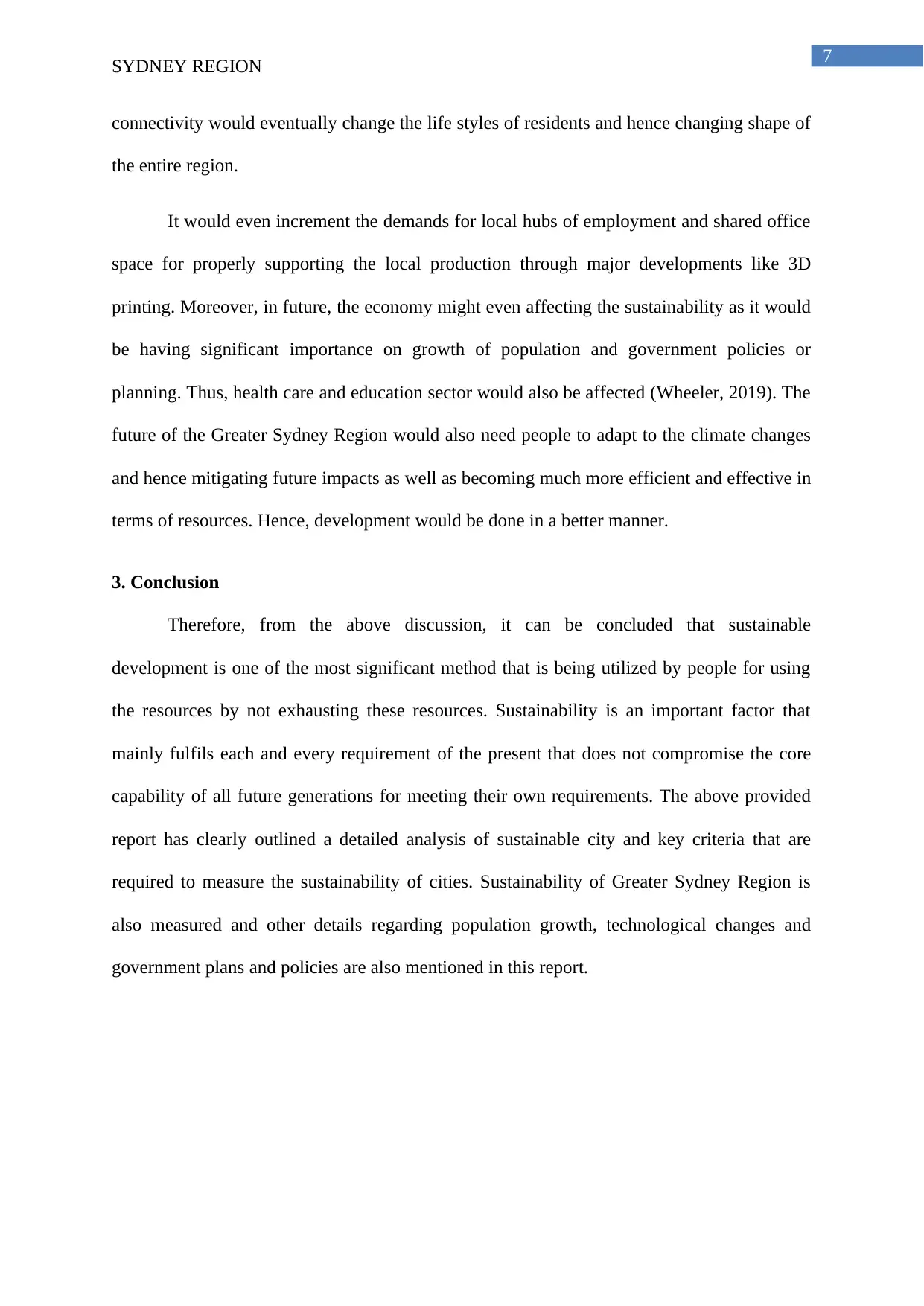
7
SYDNEY REGION
connectivity would eventually change the life styles of residents and hence changing shape of
the entire region.
It would even increment the demands for local hubs of employment and shared office
space for properly supporting the local production through major developments like 3D
printing. Moreover, in future, the economy might even affecting the sustainability as it would
be having significant importance on growth of population and government policies or
planning. Thus, health care and education sector would also be affected (Wheeler, 2019). The
future of the Greater Sydney Region would also need people to adapt to the climate changes
and hence mitigating future impacts as well as becoming much more efficient and effective in
terms of resources. Hence, development would be done in a better manner.
3. Conclusion
Therefore, from the above discussion, it can be concluded that sustainable
development is one of the most significant method that is being utilized by people for using
the resources by not exhausting these resources. Sustainability is an important factor that
mainly fulfils each and every requirement of the present that does not compromise the core
capability of all future generations for meeting their own requirements. The above provided
report has clearly outlined a detailed analysis of sustainable city and key criteria that are
required to measure the sustainability of cities. Sustainability of Greater Sydney Region is
also measured and other details regarding population growth, technological changes and
government plans and policies are also mentioned in this report.
SYDNEY REGION
connectivity would eventually change the life styles of residents and hence changing shape of
the entire region.
It would even increment the demands for local hubs of employment and shared office
space for properly supporting the local production through major developments like 3D
printing. Moreover, in future, the economy might even affecting the sustainability as it would
be having significant importance on growth of population and government policies or
planning. Thus, health care and education sector would also be affected (Wheeler, 2019). The
future of the Greater Sydney Region would also need people to adapt to the climate changes
and hence mitigating future impacts as well as becoming much more efficient and effective in
terms of resources. Hence, development would be done in a better manner.
3. Conclusion
Therefore, from the above discussion, it can be concluded that sustainable
development is one of the most significant method that is being utilized by people for using
the resources by not exhausting these resources. Sustainability is an important factor that
mainly fulfils each and every requirement of the present that does not compromise the core
capability of all future generations for meeting their own requirements. The above provided
report has clearly outlined a detailed analysis of sustainable city and key criteria that are
required to measure the sustainability of cities. Sustainability of Greater Sydney Region is
also measured and other details regarding population growth, technological changes and
government plans and policies are also mentioned in this report.
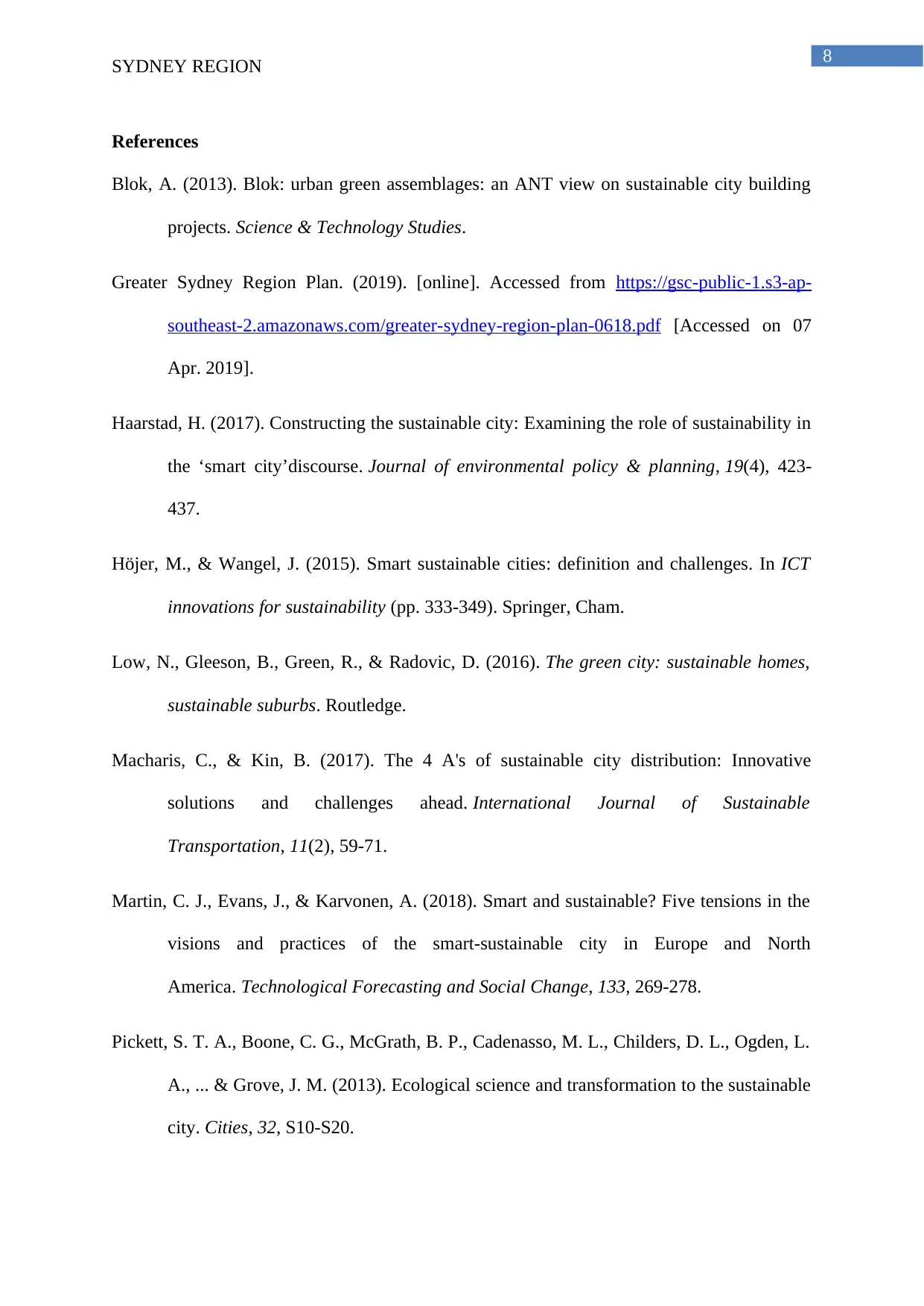
8
SYDNEY REGION
References
Blok, A. (2013). Blok: urban green assemblages: an ANT view on sustainable city building
projects. Science & Technology Studies.
Greater Sydney Region Plan. (2019). [online]. Accessed from https://gsc-public-1.s3-ap-
southeast-2.amazonaws.com/greater-sydney-region-plan-0618.pdf [Accessed on 07
Apr. 2019].
Haarstad, H. (2017). Constructing the sustainable city: Examining the role of sustainability in
the ‘smart city’discourse. Journal of environmental policy & planning, 19(4), 423-
437.
Höjer, M., & Wangel, J. (2015). Smart sustainable cities: definition and challenges. In ICT
innovations for sustainability (pp. 333-349). Springer, Cham.
Low, N., Gleeson, B., Green, R., & Radovic, D. (2016). The green city: sustainable homes,
sustainable suburbs. Routledge.
Macharis, C., & Kin, B. (2017). The 4 A's of sustainable city distribution: Innovative
solutions and challenges ahead. International Journal of Sustainable
Transportation, 11(2), 59-71.
Martin, C. J., Evans, J., & Karvonen, A. (2018). Smart and sustainable? Five tensions in the
visions and practices of the smart-sustainable city in Europe and North
America. Technological Forecasting and Social Change, 133, 269-278.
Pickett, S. T. A., Boone, C. G., McGrath, B. P., Cadenasso, M. L., Childers, D. L., Ogden, L.
A., ... & Grove, J. M. (2013). Ecological science and transformation to the sustainable
city. Cities, 32, S10-S20.
SYDNEY REGION
References
Blok, A. (2013). Blok: urban green assemblages: an ANT view on sustainable city building
projects. Science & Technology Studies.
Greater Sydney Region Plan. (2019). [online]. Accessed from https://gsc-public-1.s3-ap-
southeast-2.amazonaws.com/greater-sydney-region-plan-0618.pdf [Accessed on 07
Apr. 2019].
Haarstad, H. (2017). Constructing the sustainable city: Examining the role of sustainability in
the ‘smart city’discourse. Journal of environmental policy & planning, 19(4), 423-
437.
Höjer, M., & Wangel, J. (2015). Smart sustainable cities: definition and challenges. In ICT
innovations for sustainability (pp. 333-349). Springer, Cham.
Low, N., Gleeson, B., Green, R., & Radovic, D. (2016). The green city: sustainable homes,
sustainable suburbs. Routledge.
Macharis, C., & Kin, B. (2017). The 4 A's of sustainable city distribution: Innovative
solutions and challenges ahead. International Journal of Sustainable
Transportation, 11(2), 59-71.
Martin, C. J., Evans, J., & Karvonen, A. (2018). Smart and sustainable? Five tensions in the
visions and practices of the smart-sustainable city in Europe and North
America. Technological Forecasting and Social Change, 133, 269-278.
Pickett, S. T. A., Boone, C. G., McGrath, B. P., Cadenasso, M. L., Childers, D. L., Ogden, L.
A., ... & Grove, J. M. (2013). Ecological science and transformation to the sustainable
city. Cities, 32, S10-S20.
⊘ This is a preview!⊘
Do you want full access?
Subscribe today to unlock all pages.

Trusted by 1+ million students worldwide
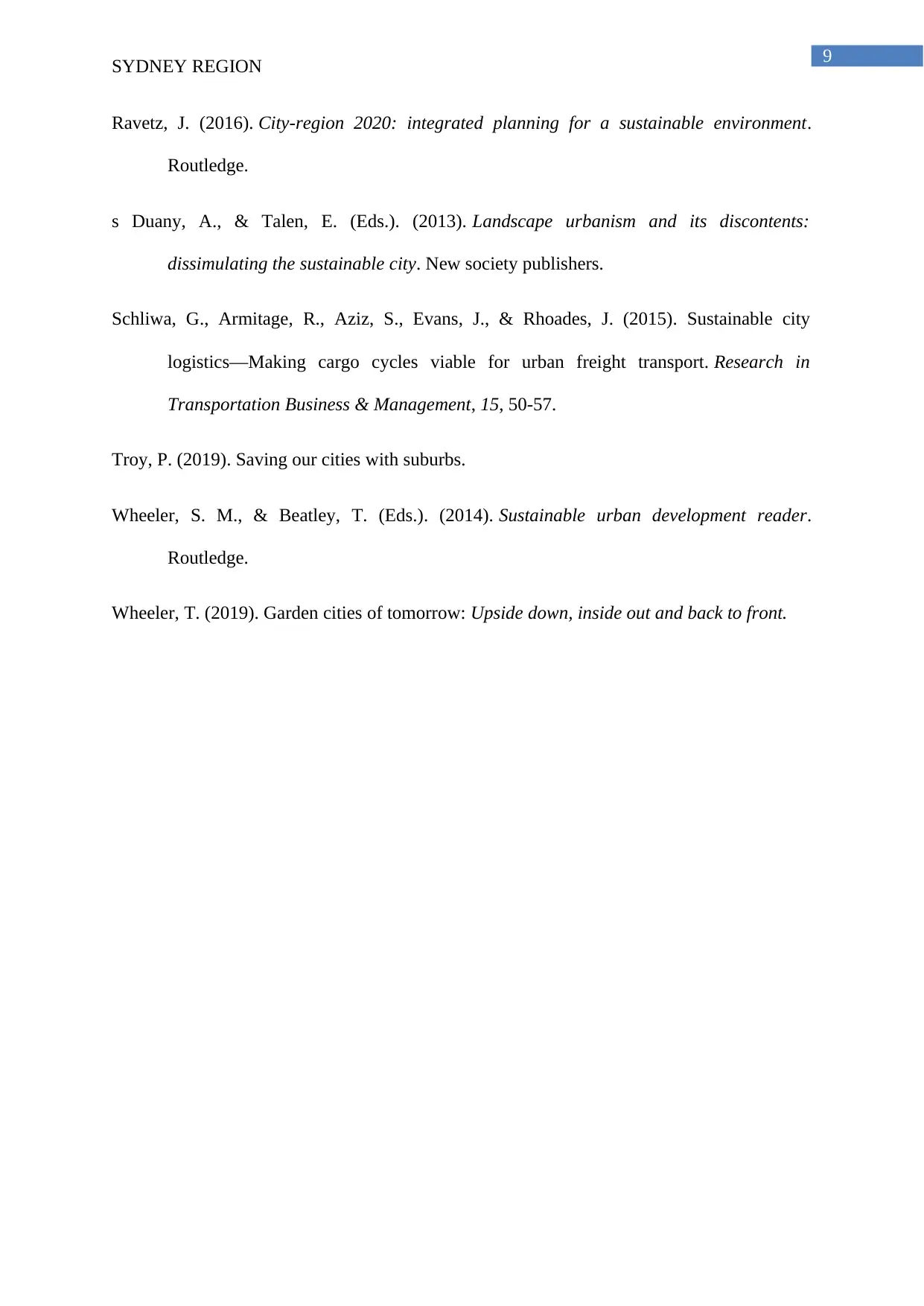
9
SYDNEY REGION
Ravetz, J. (2016). City-region 2020: integrated planning for a sustainable environment.
Routledge.
s Duany, A., & Talen, E. (Eds.). (2013). Landscape urbanism and its discontents:
dissimulating the sustainable city. New society publishers.
Schliwa, G., Armitage, R., Aziz, S., Evans, J., & Rhoades, J. (2015). Sustainable city
logistics—Making cargo cycles viable for urban freight transport. Research in
Transportation Business & Management, 15, 50-57.
Troy, P. (2019). Saving our cities with suburbs.
Wheeler, S. M., & Beatley, T. (Eds.). (2014). Sustainable urban development reader.
Routledge.
Wheeler, T. (2019). Garden cities of tomorrow: Upside down, inside out and back to front.
SYDNEY REGION
Ravetz, J. (2016). City-region 2020: integrated planning for a sustainable environment.
Routledge.
s Duany, A., & Talen, E. (Eds.). (2013). Landscape urbanism and its discontents:
dissimulating the sustainable city. New society publishers.
Schliwa, G., Armitage, R., Aziz, S., Evans, J., & Rhoades, J. (2015). Sustainable city
logistics—Making cargo cycles viable for urban freight transport. Research in
Transportation Business & Management, 15, 50-57.
Troy, P. (2019). Saving our cities with suburbs.
Wheeler, S. M., & Beatley, T. (Eds.). (2014). Sustainable urban development reader.
Routledge.
Wheeler, T. (2019). Garden cities of tomorrow: Upside down, inside out and back to front.
1 out of 10
Related Documents
Your All-in-One AI-Powered Toolkit for Academic Success.
+13062052269
info@desklib.com
Available 24*7 on WhatsApp / Email
![[object Object]](/_next/static/media/star-bottom.7253800d.svg)
Unlock your academic potential
© 2024 | Zucol Services PVT LTD | All rights reserved.




